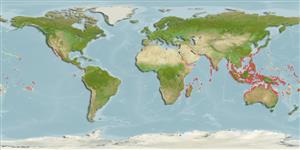>
Syngnathiformes (Pipefishes and seahorses) >
Syngnathidae (Pipefishes and seahorses) > Syngnathinae
Etymology: Syngnathoides: Greek, syn, symphysis = grown together + Greek, gnathos = jaw (Ref. 45335).
More on author: Bloch.
Environment: milieu / climate zone / depth range / distribution range
Ecologia
marino associati a barriera corallina; non migratori; distribuzione batimetrica 0 - 10 m (Ref. 90102). Tropical; 32°N - 32°S
Indo-Pacific: Red Sea and Knysna, South Africa (Ref. 4281) to Samoa, north to southern Japan, south to New South Wales.
Length at first maturity / Size / Peso / Age
Maturity: Lm ?, range 19 - ? cm
Max length : 29.0 cm TL maschio/sesso non determinato; (Ref. 4281)
Short description
Chiavi di identificazione | Morfologia | Morfometria
Spine dorsali (totale) : 0; Raggi dorsali molli (totale) : 38 - 48; Spine anali: 0; Raggi anali molli: 4. Variable green to brown or grey, depending on habitat (Ref. 48635).
Occur in protected coastal shallows over or among algae, seagrasses (Ref. 41878), or floating weeds (Ref. 1602). Juveniles occasionally found near the surface (Ref. 4281). Ovoviviparous (Ref. 205). The males carry the eggs in a brood pouch which is found under the tail (Ref. 205). Used in Chinese medicine to extract Hailong, one of the important drugs (Ref. 12206). Has been reared in captivity (Ref. 35416).
Male carries the eggs in a brood pouch (Ref. 205).
Myers, R.F., 1991. Micronesian reef fishes. Second Ed. Coral Graphics, Barrigada, Guam. 298 p. (Ref. 1602)
IUCN Red List Status (Ref. 130435)
Threat to humans
Harmless
Human uses
Pesca: commerciale; Acquario: Acquari pubblici
Strumenti
Special reports
Download XML
Fonti Internet
Estimates based on models
Preferred temperature (Ref.
123201): 24.9 - 29.3, mean 28.4 °C (based on 3423 cells).
Phylogenetic diversity index (Ref.
82804): PD
50 = 1.0000 [Uniqueness, from 0.5 = low to 2.0 = high].
Bayesian length-weight: a=0.00037 (0.00016 - 0.00085), b=3.18 (2.99 - 3.37), in cm total length, based on LWR estimates for this (Sub)family-body shape (Ref.
93245).
Trophic level (Ref.
69278): 3.6 ±0.6 se; based on diet studies.
Generation time: 1.3 ( na - na) years. Estimated as median ln(3)/K based on 2
growth studies.
Resilienza (Ref.
120179): Medio, tempo minimo di raddoppiamento della popolazione 1.4 - 4.4 anni (Assuming annual Fec<1000).
Fishing Vulnerability (Ref.
59153): Low vulnerability (16 of 100).
Nutrients (Ref.
124155): Calcium = 90.5 [50.9, 169.1] mg/100g; Iron = 0.81 [0.45, 1.52] mg/100g; Protein = 18.3 [17.1, 19.5] %; Omega3 = 0.0989 [, ] g/100g; Selenium = 32.7 [16.8, 72.0] μg/100g; VitaminA = 52.1 [17.5, 149.6] μg/100g; Zinc = 1.4 [0.9, 2.1] mg/100g (wet weight);
